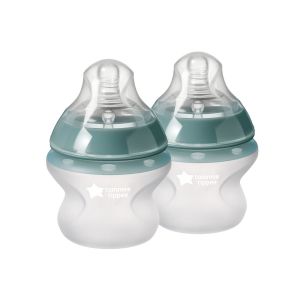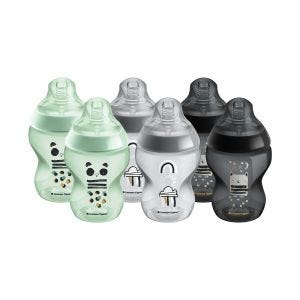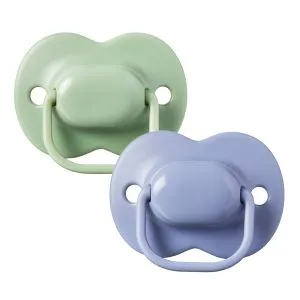
Subscribe to Save
Subscription orders can be cancelled at anytime. Standard delivery will be charged on each subscription order. Find out more about subscriptions.
Why parents love our subscriptions...
-
They’re easy and fuss free
-
Your products are automatically sent to you
-
You save when you sign up for a subscription
-
You can cancel at any time

Closer to Nature Silicone Baby Bottle
Getting Started
Great to see that you’ve purchased our Closer to Nature Silicone baby bottles. To help you get started and to keep your product working effectively, we’ve added all the guidance you should need within this area, as well as some handy hints and tips and troubleshooting advice.
PARTS GUIDE
A step by step guide to all the component parts and how they can be fitted together.
- A Bottle Hood
- B Teat
- C Screw Ring
- D Travel Lid
- E Silicone Bottle Base
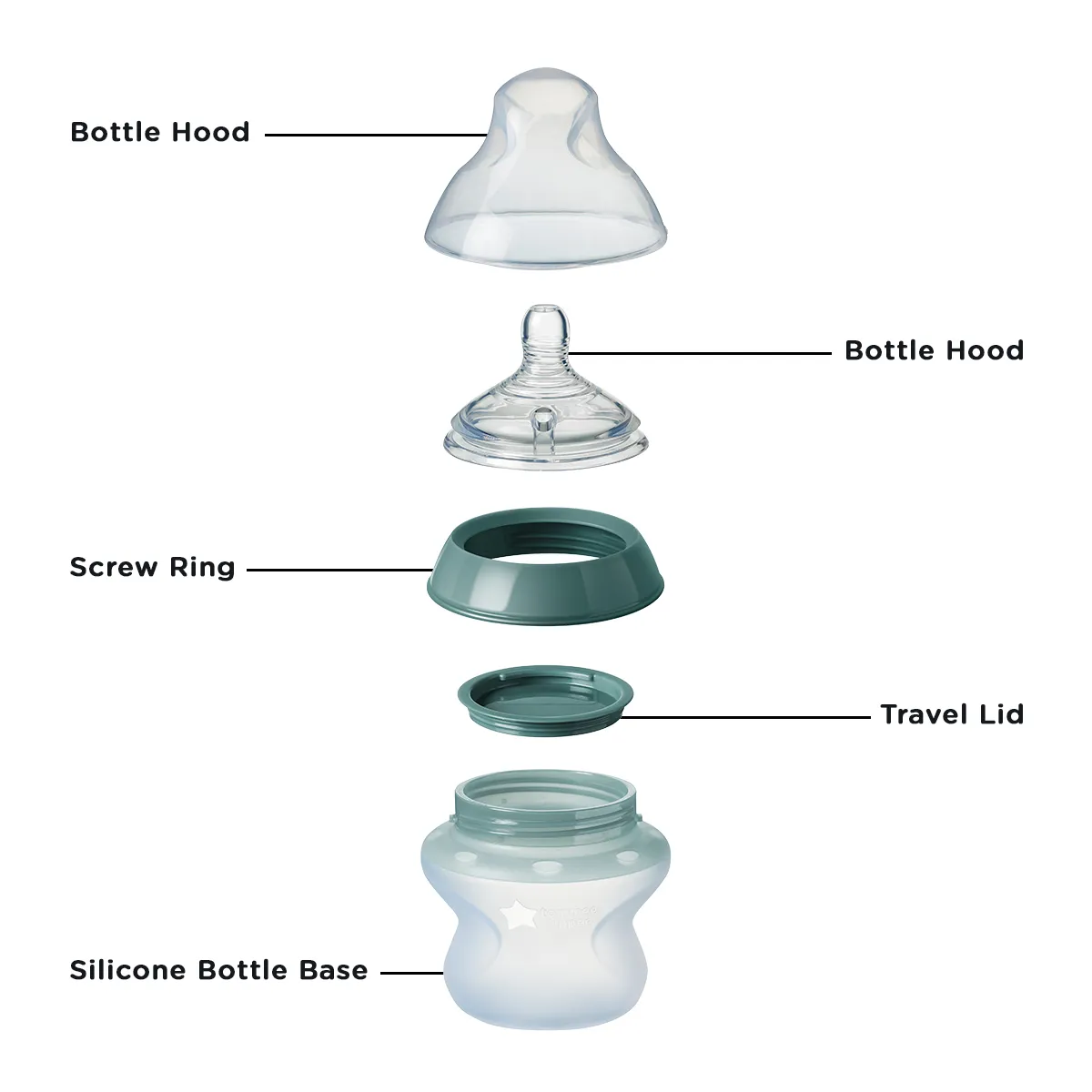


How to use Tommee Tippee Silicone Baby Bottles
Getting Set Up:
- Before first use, disassemble all parts and place in boiling water for 5 minutes, this is to ensure good hygiene
- Clean before first and each use
- Always wash the product immediately after each use
- Clean in warm soapy water or in dishwasher (top shelf only)
- For cleaning, use a TT bottle and teat brush
- Sterilise all parts of the bottles after cleaning and before use (all bottle parts are suitable for sterilisation by steam (electric or microwave), boiling or cold-water tablet/liquid solution.
*Inspect before each use and pull the feeding teat in all directions** For safety and hygiene reasons it’s recommended that the feeding teat is replaced every 2-months or sooner if damage or weakness is noticed
How do I use the travel cap in the silicone bottle?
To fit the travel cap, make sure you have the cap the right way up first. The cap should have the edge ridges facing up before you place this on the bottle base.

Where should the valve be when I'm feeding my baby?
The valve will work wherever it’s positioned but the best place for the valve is at the top, near your baby's nose.
Can I use Advanced Anti-Colic teats on closer to nature silicone baby bottles?
The simple answer is no, due to the different valves. Most of our products have interchangeable parts to make life as simple as possible. But the Closer to Nature Teats have a built-in air valve, and don’t work properly on our Advanced Anti-Colic bottles.
How long do teats last?
Teats take quite a lot of hammering from little gums and teeth, so they need to be changed regularly. We recommend replacing teats every 2-months or at the first sign of any damage or weakness.
Can I buy bottles with faster flowing teats?
All of our bottles Silicone Baby Bottles come with slow flow teats as standard, as they’re best for newborns and most parents generally stock up on bottles before baby arrives.
As your baby grows and can feed more quickly, you can buy faster flowing replacement teats.
We have medium flow teats, which most babies are ready for at around 3 months, and a fast flow teat which is best from around 6 months. The ages are only guides though - you know your baby better than anyone and will be able to tell when they’re ready for a faster flow.

I've heard bad things about BPA - Is it in your bottles? (& What is it anyway?)
All Tommee Tippee bottles are BPA-free. These bottles are made of Silicone but are BPA free for your reassurance. BPA - that’s (CH₃)₂C(C₆H₄OH)₂ for you science geeks - is a chemical that’s been used in some plastics since the 1960s and it’s believed to mess around with your hormones. It’s generally not good, so we don’t use it.
Can I store breast milk in bottles?
Yes, our bottles love to look after your breast milk. We even have special lids that you can pop on to store your milk in the fridge or freezer. If you’re expressing and storing breast milk, our Express and Go™ range may be handy too - it features a clever pouch that you use to express, store, warm and feed (it’s our all in one show). This means there’s no need to transfer milk at any stage, so you’ll never lose a precious drop.
Can I recycle my bottles when I'm done?
Yes. Our Silicone baby Bottles are made from Silicone and can be recycled.
CLEANING & MAINTENANCE
DOS
- Before first use, disassemble all parts and place in boiling water for 5 minutes, this is to ensure good hygiene
- Clean before first and each use
- Always wash the product immediately after each use
- Clean in warm soapy water or in dishwasher (top shelf only)
- For cleaning, use a TT bottle and teat brush
- Sterilise all parts of the bottles after cleaning and before use (all bottle parts are suitable for sterilisation by steam (electric or microwave), boiling or cold-water tablet/liquid solution.
- Inspect before each use and pull the feeding teat in all directions
- Throw away at first sign of damage or weakness
- For safety and hygiene reasons it’s recommended that the feeding teat is replaced every 2-months
DON'TS
- Do not clean with solvents or harsh chemicals
- Do not allow product to come into contact with oil-based foods e.g. tomato based sauces or carrots
- Do not turn the teat inside out for cleaning as damage could result
- Store or leave in direct sunlight or near a source of heat, or leave in disinfectant (“sterilising solution”) for longer than recommended as this may weaken the teat
- Do not store with or allow to come into contact with solvents or harsh chemicals
- Not suitable for use in a conventional oven or a combination microwave with the grill feature switched on
- Do not heat in a microwave with the bottle sealed. Remove the teat, screw ring and bottle hand first
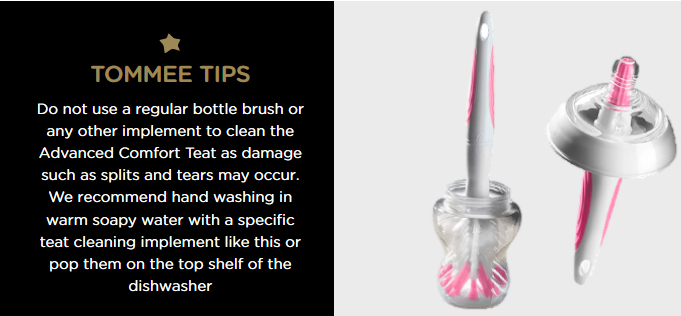
WARNINGS
- FOR YOUR CHILDS SAFETY & HEALTH WARNING!
- ALWAYS use this product with adult supervision. Accidents have occurred when babies have been left alone with drinking equipment due to the baby falling or if the product has been dissassembled
- Always check food temperatures before feeding. Heating in a microwave oven may produce localised high temperatures. Take extra care when microwave heating.
- Always stir heated food to ensure even heat distribution and test the temperature before serving.
- When making up a feed, follow the formula milk manufacturer's instructions and allow the freshly boiled water to cool before pouring it into the bottle
- NEVER use feeding teats as a soother.
- Continous and prolonged sucking of fluids will cause tooth decay. Tooth decay in young children can occur even when non-sweetened fluids are used. This can occur if the baby is allowed to use the bottle for long periods through the day and particularly through the night, when saliva flow is reduced or if it is used a soother.

Is it ok to put bottles in the dishwasher?
Of course! Pop them on the top shelf though. As with all white and clear plastic things they can get a bit stained and yucky-looking in the dishwasher (blame that Bolognese sauce or carrot soup you had last night). If they do get discoloured there’s nothing to worry about - they’re perfectly safe, they just don’t look as nice.
Can I recycle my bottles when I'm done?
Yes. Our Silicone baby Bottles are made from Silicone and can be recycled.
Troubleshooting
My teats don't seem to last very long?
Teats take quite a lot of hammering from little gums and teeth, so they need to be changed regularly. We recommend replacing teats every 2-months or at the first sign of any damage or weakness.
Where should the valve be when I'm feeding my baby?
The valve will work wherever it’s positioned but the best place for the valve is at the top, near your baby's nose.
Can I use Advanced Anti-Colic teats on closer to nature silicone baby bottles?
The simple answer is no, due to the different valves. Most of our products have interchangeable parts to make life as simple as possible. But the Closer to Nature Teats have a built-in air valve, and don’t work properly on our Advanced Anti-Colic bottles.
How do I fit the travel cap in the silicone bottle?
To fit the travel cap, make sure you have the cap the right way up. The cap should have the edges facing up before you place this on the bottle base.


